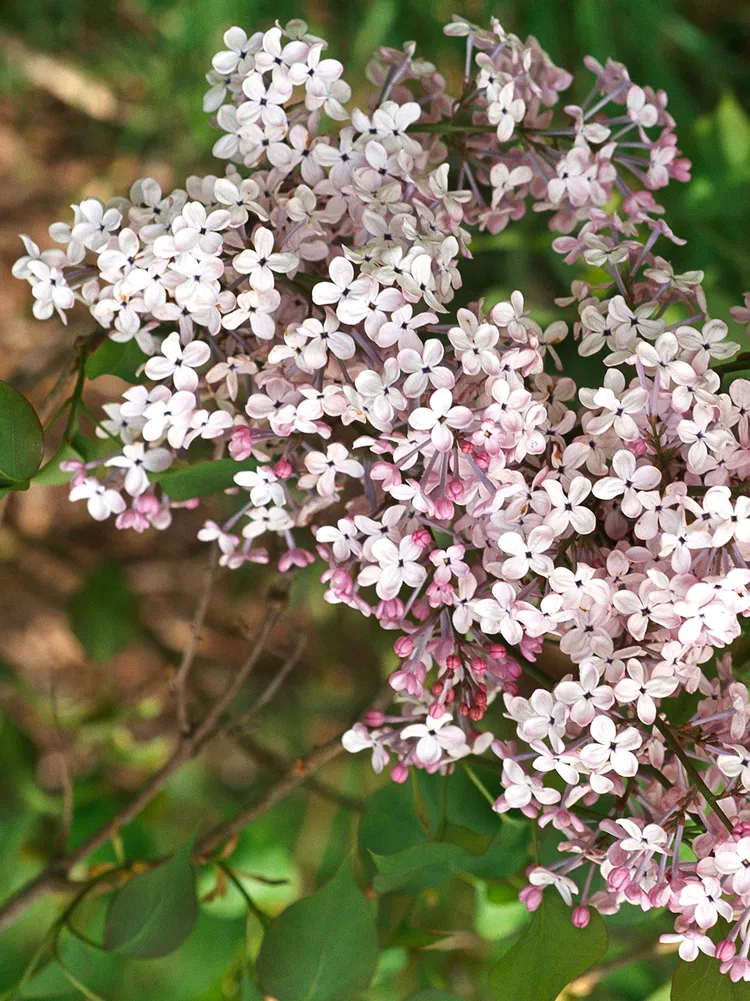While trimming is an annual task for many woody plants in the landscape, some low-maintenance shrubs don't demand pruning at all. In fact, these shrubs develop the most pleasing shape without any shearing or shaping. They'll grow easily, have refined forms, and generally thrive without pruning. And you'll be able to use your pruning shears for more inviting tasks, such as cutting a bouquet of flowers. Plant several of these easy-care, no-pruning-required shrubs, and you'll create a lush and wildlife-friendly landscape.
The very best way to minimize pruning when planting new shrubs is to put the right plant in the right place. Pay close attention to mature plant size. Pair your available planting space with a shrub that has a mature size smaller than the planting spot. Don’t forget that nearby plants will grow and expand too.
American Arborvitae
An easy-care and cold tolerant evergreen shrub, American arborvitae (Thuja occidentalis) makes an excellent hedge plant. It has a soft texture and medium green color. Its dense branching gives it a compact form that doesn’t need pruning, although it can be sheared for a more shaped, formal appearance if desired.
Growing Conditions: Full sun to part shade and well-drained soil
Size: 4-30 feet tall
Zones: 3–8
Boxwood
Slow-growing boxwood (Buxus spp.) is a perfect candidate for the no-pruning-needed club of low maintenance shrubs. Boxwood is known for its compact growth and petite evergreen leaves. Plant boxwood where it has space to expand to its mature size and you’ll enjoy these easy-care shrubs for years.
Growing Conditions: Full sun to part shade and moist, well-drained soil
Size: 2-10 feet, depending on type
Zones: 4–9
Dwarf Conifers
Year-round color and interest make dwarf conifers a valuable part of any planting—from entryway gardens to low maintenance shrub borders. There are many varieties of dwarf conifers, and most top out at less than 5 feet tall and wide, growing just a few inches each year. For an upright, conical structure, a dwarf Alberta spruce (Picea glauca 'Conica', shown here) may be a good fit. For a more rounded form with a cool blue hue, try dwarf globe blue spruce (Picea pungens 'Globosa').
Growing Conditions: Full sun to part shade and well-drained soil
Size: 2-5 feet tall, depending on type
Zones: 3–9
Indian Hawthorn
Indian hawthorn (Rhapheolepis indica) is an excellent evergreen shrub for use as a hedge plant or an accent in a shrub border in places with mild winters. After blooming for many weeks in late winter to early spring, it takes a break until revealing a new set of flowers in fall. Look for 'Eleanor Taber' or 'Ballerina,' two long-blooming varieties prized for their small size (2-4 feet tall).
Growing Conditions: Full sun to part shade and average, well-drained soil; drought-tolerant
Size: 4 to 6 feet tall
Zones: 8–10
Inkberry Holly
A slow-growing shrub with evergreen foliage, inkberry holly (Ilex glabra) is native to eastern North America. In the fall, small black berries form on female plants, attracting birds. Newer cultivars, such as ‘Nordic’ and ‘Gem Box’, have dense growth habits, creating lush, round orbs in the landscape year-round without the need for pruning.
Growing Conditions: Full sun to full shade: tolerates a wide range of soils, from dry and sandy soil to slow-draining clay
Size: 5-8 feet
Zones: 3–9
Meyer Lilac
A compact version of the rangy traditional lilac, Meyer lilac (Syringa meyeri) is a round, slow-growing, low-maintenance shrub that sports dense clusters of violet-purple flowers in the spring. The flower clusters fade and seemingly disappear into the clean green foliage.
Growing Conditions: Full sun to part shade and average soil; tolerates periods of drought
Size: 4 to 5 feet tall
Zones: 3–7
Rose of Sharon
Popular with bees and hummingbirds, rose of Sharon (Hibiscus syriacus) is a summer-blooming shrub loaded with large flowers from midsummer through frost. Plant this low-maintenance shrub where it can expand to 10 to 12 feet tall and 4 to 6 feet wide.
Growing Conditions: Full sun and moist, well-drained soil; drought-tolerant
Size: 10-12 feet tall
Zones: 5–9
Viburnums
There are many varieties of viburnums to choose from. Generally, viburnums have an upright, loose habit and grow 6 to 12 feet or more tall. Viburnums are prized for their spring flowers, summer or fall berries, and colorful autumn foliage. Korean Spice (Viburnum carlesii, shown here) and burkwood viburnum (Viburnum x burkwoodii) are delightfully fragrant species.
Growing Conditions: Full sun or part shade and moist, well-drained soil
Size: 5-12 feet tall
Zones: 4–8
These low-maintenance shrubs thrive in a variety of growing conditions. From heat to drought to wet planting sites, there's a shrub for nearly every growing challenge in this list. Plant these shrubs where they can expand to their mature size, and there will be no need to prune them aside from removing dead, diseased, or broken branches occasionally.
Follow these tips for evergreen shrubs that need pruning to keep them looking their best, and use our guide to when to prune the plants in your yard to stay on top of each shrub's needs while avoiding common mistakes that can harm your greenery.




















